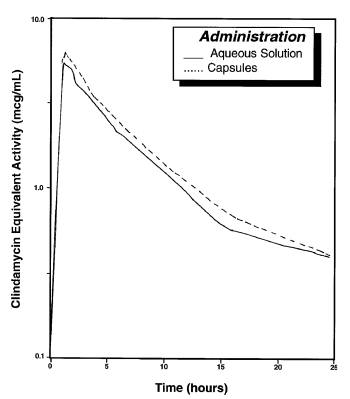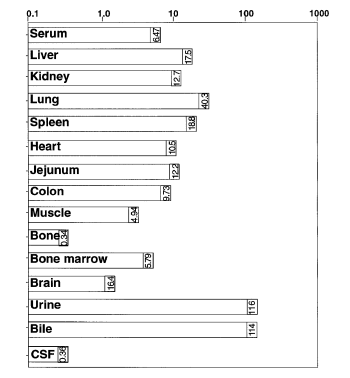Antirobe Capsules (150 mg) (Canada)
This page contains information on Antirobe Capsules (150 mg) for veterinary use.The information provided typically includes the following:
- Antirobe Capsules (150 mg) Indications
- Warnings and cautions for Antirobe Capsules (150 mg)
- Direction and dosage information for Antirobe Capsules (150 mg)
Antirobe Capsules (150 mg)
This treatment applies to the following species: Company: Zoetis
Company: Zoetis
clindamycin capsules (as clindamycin hydrochloride)
clindamycin oral solution (as clindamycin hydrochloride)
DIN 00813532
DIN 00813540
DIN 00813524
DIN 00813575
Veterinary Use Only
Description
ANTIROBE capsules and ANTIROBE AQUADROPS solution contain: Medicinal ingredient: Clindamycin (as clindamycin hydrochloride), which is the hydrated salt of clindamycin. Clindamycin is a semi-synthetic antibiotic produced by a 7 (S) - chloro-substitution of the 7 (R) -hydroxyl group of lincomycin, a natural origin antibiotic produced by Streptomyces lincolnensis var. lincolnensis.
Actions
Site and Mode of Action: Clindamycin is an inhibitor of protein synthesis in the bacterial cell. The site of binding appears to be in the 50S sub-unit of the ribosome. Binding occurs to the soluble RNA fraction of certain ribosomes, thereby inhibiting the binding of amino acids to those ribosomes. Clindamycin differs from cell wall inhibitors in that it causes irreversible modification of the protein-synthesizing sub-cellular elements at the ribosomal level.
Microbiology: The following clindamycin in vitro data are available, but their clinical significance is unknown. Clindamycin has been shown to have in vitro activity against isolates of the following organisms:
Aerobic gram positive cocci, including: Staphylococcus aureus (penicillinase and non-penicillinase producing strains), Staphylococcus intermedius, Staphylococcus simulans, Staphylococcus epidermidis, streptococci (except S. faecalis), pneumococci.
Anaerobic gram negative bacilli, including: Bacteroides species, Fusobacterium species.
Anaerobic gram positive non-sporeforming bacilli, including: Propionibacterium, Eubacterium, Actinomyces species. Anaerobic and microaerophillic gram positive cocci, including: Peptococcus species, Peptostreptococcus species, microaerophillic streptococci.
Clostridia: Most C. perfringens are susceptible, but other species, e.g., C. sporogenes and C. tertium, are frequently resistant to clindamycin.
Mycoplasma species: Most Mycoplasma species are susceptible to clindamycin. Clindamycin and erythromycin show parallel resistance. Partial cross resistance has been demonstrated between clindamycin, erythromycin and macrolide antibiotics.
Pharmacology
Absorption: Clindamycin hydrochloride is rapidly absorbed from the canine and feline gastrointestinal tract. Dogs and cats orally dosed with therapeutic amounts of clindamycin hydrochloride demonstrated antibacterial serum levels of the drug within 15 minutes post-dosing.
Canine Serum Levels: Therapeutically effective serum levels of clindamycin hydrochloride can be maintained by oral dosing at the rate of 5.5 mg/kg every 12 hours. Dogs orally dosed with clindamycin hydrochloride at 5.5 mg/kg every 12 hours during a 72 hour dosing regimen continuously maintained antibacterial serum levels of the drug. This same study revealed that average peak serum concentrations occurred 1 hour and 15 minutes after dosing. The biological half-life for clindamycin hydrochloride in dog serum is approximately 5 hours. There was no bioactivity accumulation after a regimen of multiple oral doses.
Feline Serum Levels: Therapeutically effective serum levels of clindamycin hydrochloride can be maintained by oral dosing at the rate of 11 - 22 mg/kg body weight once every 24 hours. The average peak serum concentration of clindamycin hydrochloride occurs about 1 hour after oral administration. The biological half-life of clindamycin hydrochloride in feline serum is approximately 7.5 hours. No bioactivity accumulation occurs after multiple oral doses of clindamycin hydrochloride.
Feline Clindamycin Serum Concentrations
11 mg/kg Orally

Feline Tissue Levels: Tissue concentrations measured at 10 days (µg/g; means) of clindamycin hydrochloride liquid in cats 2 hours after oral administration at 22 mg/kg body weight once every 24 hours for 10 days.

Metabolism And Excretion
Extensive studies of the metabolism and excretion of clindamycin hydrochloride administered orally in animals and humans have shown that unchanged drug and bioactive and bioinactive metabolites are excreted in urine and feces. Almost all of the bioactivity detected in serum after ANTIROBE capsules administration is due to the parent molecule (clindamycin). Urine bioactivity, however, reflects a mixture of clindamycin and active metabolites, especially N-demethyl clindamycin and clindamycin sulfoxide.
Toxicology And Safety
Animal toxicity studies with clindamycin hydrochloride showed the following:
LD50 I.P. Administration - Mouse, 419 mg/kg
LD50 I.V. Administration - Mouse, 143 mg/kg
LD50 Oral Administration - Rat, 2618 mg/kg
One year oral toxicity studies in rats and dogs at doses of 30, 100 and 300 mg/kg/day have shown clindamycin hydrochloride to be well tolerated. Differences did not occur in the parameters evaluated to assess toxicity when comparing groups of treated animals with contemporary controls. Rats administered clindamycin hydrochloride at 600 mg/kg/day for six months tolerated the drug well; however, dogs orally dosed at 600 mg/kg/day vomited, had anorexia, and subsequently lost weight. Safety studies in gestating bitches or breeding males have not been run, however, teratology and reproductive studies in male and female rats at 50 mg/kg and higher showed no drug related effects.
Clindamycin hydrochloride (ANTIROBE AQUADROPS solution) was well tolerated with little evidence of toxicity in domestic shorthair cats when administered orally at 10x the minimum recommended therapeutic daily dose of 11 mg/kg for 15 days, at doses up to 5x the minimum recommended therapeutic dose for 42 days. Gastrointestinal tract upset (soft feces to diarrhea) occurred in control and treated cats with emesis occurring at doses 3x or greater than the minimum recommended therapeutic dose (11 mg/kg/day). Lymphocytic inflammation of the gallbladder was noted in a greater number of treated cats at the 110 mg/kg/day dose level than for control cats. No other effects were noted. Safety in gestating queens or breeding male cats has not been established.
Antirobe Capsules (150 mg) Indications
Dogs: For treatment of infected wounds, abscesses and dental infections caused by or associated with Staphylococcus spp., Streptococcus spp., Bacteroides spp., Fusobacterium necrophorum and Clostridium perfringens and osteomyelitis caused by Staphylococcus aureus.
Antirobe Capsules (150 mg) Dosage And Administration
Dogs:
Infected Wounds, Abscesses and Dental Infections: 5.5 mg/kg body weight every 12 hours.
|
kg of body weight, each: |
capsule/solution dosing |
|
4.5 kg |
one (1) 25 mg capsule or one (1) mL (25 mg) solution |
|
14 kg |
one (1) 75 mg capsule |
|
27 kg |
one (1) 150 mg capsule |
Treatment with ANTIROBE capsules or ANTIROBE AQUADROPS solution may be continued up to a maximum of 28 days if clinical judgment indicates. Treatment of acute infections should not be continued for more than three or four days if no response to therapy is seen.
Canine osteomyelitis: 11 mg/kg body weight every 12 hours.
|
kg of body weight, each: |
capsule/solution dosing |
|
2 kg |
one (1) 25 mg capsule |
|
7 kg |
one (1) 75 mg capsule |
|
14 kg |
one (1) 150 mg capsule |
|
4.5 kg |
two (2) mL (50 mg) solution |
Treatment with ANTIROBE capsules or ANTIROBE AQUADROPS solution is recommended for a minimum of 28 days. Treatment should not be continued for longer than 28 days if no response to therapy is seen.
Antirobe Capsules (150 mg) Indications
Cats: For treatment of infected wounds, abscesses and dental infections caused by or associated with Staphylococcus aureus, Staphylococcus intermedius, Streptococcus spp., Clostridium perfringens and Bacteroides fragilis.
Antirobe Capsules (150 mg) Dosage And Administration
Cats:
11 - 22 mg/kg body weight of ANTIROBE AQUADROPS solution once every 24 hours, depending on the severity of the condition. To provide 11 mg/kg, administer orally 0.5 mL/kg body weight once every 24 hours; to provide 22 mg/kg, administer orally 1 mL/kg body weight once every 24 hours.
Treatment with ANTIROBE AQUADROPS solution may be continued up to a maximum of 14 days if clinical judgment indicates. Treatment of acute infections should not be continued for more than three to four days if no clinical response to therapy is seen.
IN VITRO SUSCEPTIBILITY TESTING:
Susceptibility tests should be done on samples collected prior to initiation of therapy with ANTIROBE capsules or ANTIROBE AQUADROPS solution. Clindamycin susceptibility testing is performed by using CLEOCIN™ Susceptibility Disks (clindamycin 2 µg) and CLEOCIN Susceptibility Powder (20 mg). A standardized disk testing procedure1 is recommended for determining susceptibility of aerobic bacteria to clindamycin. A description is contained in the CLEOCIN Susceptibility Disk insert. Using this method, the laboratory can designate isolates as resistant, intermediate, or susceptible. Tube or agar dilution methods may be used for aerobic and anaerobic bacteria. When the directions in the CLEOCIN Susceptibility Powder insert are followed, a MIC (minimal inhibitory concentration) of 1.6 µg/mL may be considered susceptible; MICs of 1.6 to 4.8 µg/mL may be considered intermediate and MICs greater than 4.8 µg/mL may be considered resistant.
1Bauer, A.W., W.M. Kirby, J.C. Sherris and M. Turck. Antibiotic susceptibility testing by a standardized single disk method, Am. J. Clin. Path. 45:493-496, 1966. Standardized Disk Susceptibility Test, Federal Register 37:20527-29, 1972.
Warnings
Keep out of reach of children.
CAUTIONS
1. ANTIROBE capsules and ANTIROBE AQUADROPS solution are contraindicated in animals with a history of hypersensitivity to preparations containing clindamycin or lincomycin. In the event of a hypersensitivity reaction following the administration of this drug, immediate appropriate therapy should be instituted.
2. The use of ANTIROBE capsules or ANTIROBE AQUADROPS solution occasionally results in overgrowth of non-susceptible organisms such as clostridia and yeasts. Should superinfections occur, appropriate measures should be taken as indicated by the clinical situation.
3. Because of potential adverse gastrointestinal effects, do not administer to rabbits, hamsters, guinea pigs, horses, chinchillas or ruminating animals.
4. While high dose studies in rats suggest that clindamycin is not a teratogen and did not significantly affect the reproductive performance of males or females, safety in gestating bitches and queens or breeding male dogs and cats has not been established.
5. Clindamycin hydrochloride has been shown to have neuromuscular blocking properties that may enhance the action of other neuromuscular blocking agents. Therefore, ANTIROBE capsules and ANTIROBE AQUADROPS solution should be used with caution in animals receiving such agents. Partial cross resistance has been demonstrated between clindamycin, erythromycin and macrolide antibiotics.
6. During prolonged therapy of one month or greater, periodic liver and kidney function tests and blood counts should be performed. Patients with severe renal and/or very severe hepatic disturbances accompanied by severe metabolic aberrations should be dosed with caution and should be monitored by serum examination during high-dose clindamycin therapy.
Storage
Store between 15 and 30°C.PRESENTATION:
ANTIROBE capsules:
25 mg, yellow and white capsule containing 25 mg of clindamycin. Available in bottles of 200 capsules.
75 mg, dark green and white capsule containing 75 mg of clindamycin. Available in bottles of 200 capsules.
150 mg, white and white capsule containing 150 mg of clindamycin. Available in bottles of 100 capsules.
ANTIROBE AQUADROPS solution: Palatable formulation, each mL containing 25 mg clindamycin and ethyl alcohol, 8.64%. Available in 20 mL bottles.
Zoetis is a trademark, Antirobe and Aquadrops are registered trademarks of Zoetis or its licensors, used under license by Zoetis Canada Inc.
Zoetis Canada Inc., Kirkland QC H9H 4M7
1614-11-2
11719801
CPN: 1198264.4
16,740 TRANS-CANADA HIGHWAY, KIRKLAND, QC, H9H 4M7
| Order Desk: | 800-663-8888 | |
| Technical Services Canada: | 800-461-0917 | |
| Technical Services USA: | 800-366-5288 | |
| Website: | www.zoetis.ca |
 |
THIS SERVICE AND DATA ARE PROVIDED "AS IS". Animalytix assumes no liability, and each user assumes full risk, responsibility, and liability, related to its use of the Animalytix service and data. See the Terms of Use for further details. |
Copyright © 2024 Animalytix LLC. Updated: 2024-02-27
